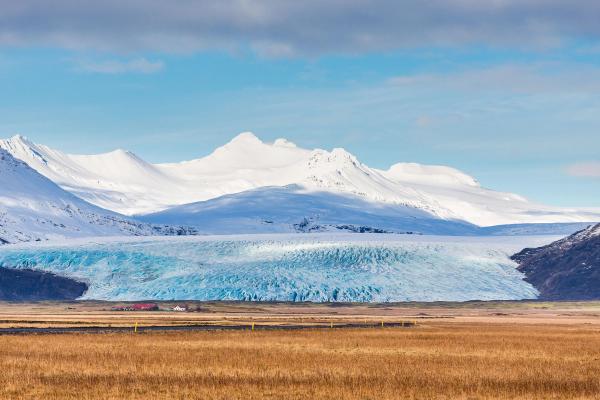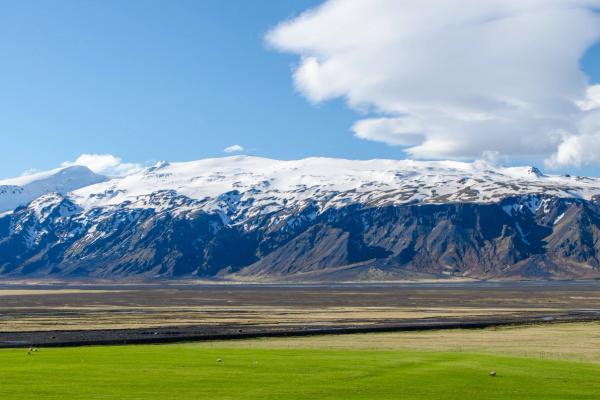
Walking on Ice: A Guide to Glaciers in Iceland
The list of reasons why people come to Iceland is quite long. There are many things to see and do here, a wide range of natural wonders that attract visitors from all over the world. And one of those things is, undoubtedly, glaciers.
Although Iceland is not as cold as many believe, and it’s not covered in snow all year round, there is a reason why ice is present in the name of the country. And that’s its glaciers. These enormous masses of ice cover a big part of the country, making them a defining characteristic and constant presence in the landscapes on the island. The glaciers offer stunning vistas and a range of outdoor adventures, and are evidence of Iceland’s geological richness.
Glaciers are not just natural monuments; they also play a crucial role in the environment, influencing weather patterns and local ecosystems. They’re also places where you can do many things. From hiking on glaciers to exploring the vibrant blue ice caves hidden below them.
Come with us and explore these ice giants!
Key Takeaways
- Glaciers cover approximately 11% of the entire surface of Iceland.
- There are around 269 glaciers in Iceland, with a variety of sizes and shapes.
- The Icelandic word for glacier is jökull, so if you see the name of a place that ends this way, you know it's a glacier.
- Vatnajökull is the largest glacier in Iceland and Europe.
What is a Glacier, And How is it Formed?
A glacier is a slow-moving river of ice formed from snow accumulation over hundreds or thousands of years. When snow falls and accumulates over time, the lower layers are compressed by the weight of the snow above, transforming the snow into dense ice. Glaciers form in areas where the amount of snowfall is consistently larger than the rate of melting. For this reason, glaciers are normally found in polar regions or high altitudes.
Glacier formation is slow but powerful. As glaciers move, they erode the soil beneath them, carving out valleys, fjords, and other features. A glacier valley is generally U-shaped. In Iceland, glaciers have played an important role in modifying the landscape, and there are many glacier valleys all over the country.

The Word Jökull in Icelandic
In Icelandic, the word for glacier is "jökull" (pronounced YO-kutl), and it's an integral part of the country's geography and culture. The term "jökull" can be found in the names of many of Iceland’s glaciers and mountains, signifying the presence of ice. If, during your stay in Iceland, you see the name of a place that ends this way, then that’s a glacier. For example, Vatnajökull, Langjökull, Snæfellsjökull, and Mýrdalsjökull are all glaciers.
Let’s take a look at some famous glaciers and the meaning of their names:
- Vatnajökull: The word "vatna" means water, so this name translates to "water glacier." Vatnajökull is Iceland's largest glacier, and many rivers flow from it.
- Langjökull: "Lang" means long, so this glacier's name translates to "long glacier," referring to its elongated shape.
- Snæfellsjökull: "Snæ" means snow, so Snæfellsjökull can be translated to "snowy mountain glacier."
General Information About Glaciers in Iceland
Most of the glaciers in Iceland, especially the bigger ones, are located in the south and the central Highlands. However, smaller glaciers can be found in the north and west of the country. It’s very difficult to know exactly the number of glaciers in Iceland, as they change and evolve over time – a very long time, though – but there are around 269 named glaciers in the country. Many of them are accessible and can be visited, while others are far more difficult to reach.
As we explained before, many of Iceland’s glaciers sit above volcanoes. This interaction has earned Iceland the nickname “Land of Ice and Fire.” This combination of glaciers and volcanic activity creates some of the country’s most dramatic and unique landscapes, such as vast ice fields, ice with black ash strikes, or glacial lagoons filled with little icebergs floating on them.
The glaciers feed many of Iceland’s rivers. When the ice melts, the water flows, providing essential sources for life in the country. Unfortunately, like glaciers worldwide, glaciers in Iceland are retreating due to global warming. There is recorded data about the reduction of the size of many glaciers, and some are expected to disappear in the future.
Despite their shrinking size, glaciers remain one of Iceland's top tourist attractions. Glaciers offer visitors opportunities for hiking, ice caving, and other related activities.

The Best Glaciers in Iceland
Iceland has a wide collection of glaciers, and most of them are worth a visit. Each one is different and unique.
Vatnajökull
Vatnajökull is the largest glacier in Iceland and the largest in Europe outside the Arctic Circle. It covers around 8% of the country’s landmass and is located in southeast Iceland. It's the main character in the Vatnajökull National Park, the largest national park on the continent.
This glacier has a variety of ice caves, which are formed naturally every winter. This is an example of the constant activity glaciers have, as the landscape transforms every year. The ice melts, carving out caves. Then it freezes again, and this process continues. Many of these caves can be visited with an expert guide.
Vatnajökull is also home to the famous Jökulsárlón glacier lagoon, where big pieces of blue ice floate on the water before drifting out to the sea.

Langjökull
Langjökull, which literally means "long glacier," is Iceland’s second-largest glacier, and it's found in the west-central Highlands. Covering about 950 square kilometers, it’s well-known for its man-made ice cave, where you can walk deep into the glacier itself.
Langjökull is also a great place for snowmobiling and ice climbing. It’s not far from Iceland’s capital, Reykjavik, making it a perfect day trip if you're staying there.

Sólheimajökull
This glacier is one of the most easily accessible glaciers in Iceland. It’s close to the route that goes along the south coast. In reality, it’s a glacier tongue that extends from the larger Mýrdalsjökull ice cap. It stands out with its dramatic ice formations, like deep crevasses and towering ridges.
What’s especially interesting about Sólheimajökull is the layer of volcanic ash on parts of it, creating a striking contrast between the blue ice and the black ash. Guided hikes are available to get a close look at this ice wonder.

Snæfellsjökull
Snæfellsjökull is easily one of Iceland’s most famous glaciers. This glacier sits on top of a dormant volcano on the Snæfellsnes Peninsula, and it’s the main feature in the Snæfellsjökull National Park.
Although challenging, there’s a hike going all the way to the top, and the views from there are astonishing. On a clear day, you can see all the way to Reykjavik. And, of course, the mountain can be seen from the capital, even if it’s 120 kilometers (75 miles) away.
This glacier is also a place of literary fame, as it is here that Jules Verne located the entrance to the world beneath the surface in “Journey to the Center of the Earth.”

Mýrdalsjökull
Down in southern Iceland, you’ll find Mýrdalsjökull, the country’s fourth-largest glacier. It’s pretty famous for the volcano Katla, which is hidden beneath it and is one of the most active volcanoes in Iceland.
Mýrdalsjökull is easily reachable from the Ring Road, and snowmobiling here is a popular activity. The nearby village of Vík, with its iconic black sand beaches, is also a must-see when you're in the area.

Hofsjökull
Hofsjökull is Iceland’s third-largest glacier and also the country’s biggest active volcano. It’s located in the remote area of the Central Highlands, and it’s a bit difficult to get there, especially in winter. In this season, the F roads of the Highlands remain closed due to the weather.
Shaped like a circular ice cap, it’s the source of several major rivers in Iceland. Access is limited, but if you’re up for the challenge, it offers a truly wild and untouched experience.

Eyjafjallajökull
This ice-capped volcano became famous worldwide in 2010 when it erupted, creating a huge ash cloud that covered part of Europe and stopped air traffic for several days.
It’s relatively small compared to other glaciers, but its volcanic history and nearby waterfalls like Seljalandsfoss and Skógafoss make it a popular tourist stop. There are guided hikes in the area, so you can get a really close view of the glacier.

Drangajökull
Although there are not many of them, glaciers can also be found in the north of the country. Drangajökull, Iceland's northernmost glacier, is the only one located in the Westfjords.
Unlike many of Iceland’s other glaciers, Drangajökull hasn’t been shrinking much due to global warming, so it’s relatively stable in size. It’s remote and a bit tricky to reach, but if you do, you’ll be rewarded with jaw-dropping views and a peaceful, off-the-beaten-path experience.

Tungnafellsjökull
Tungnafellsjökull is not as famous as other glaciers in Iceland. It’s located near Vatnajökull in the Central Highlands, so it’s perfect for those looking for some peace and quiet since it doesn’t attract as many visitors. The landscape around it is rugged and volcanic, giving it a cool contrast against the ice. T
Several geothermal areas exist in the area, where hot springs and fumaroles are visible right next to the ice.

Kaldaklofsjökull
Kaldaklofsjökull is a small but beautiful glacier in the central Highlands. It's one of Iceland’s hidden gems, perfect for those who love remote adventures.
While it's not as easy to get to as some of the larger glaciers, the stunning views and untouched wilderness make the journey totally worth it.

Travel Tips
Exploring Iceland’s glaciers is an unforgettable adventure, but it’s important to be well-prepared. Many of them can be visited, but you must follow some guidelines to make your trip as safe as memorable.
- Book a guided tour: It might seem fun to explore solo, but glaciers can be dangerous. Go with a guide who knows the terrain and can keep you safe. They will provide safety gear and great information about glaciers.
- Dress for the weather: Glacier weather can be unpredictable, so dress in layers to keep yourself warm, finishing with waterproof and windproof gear. Sturdy boots with crampons (spikes) are a must, and don’t forget gloves and a hat, even in summer. Sunglasses are advisable, too, as the sun reflecting on the ice can be very harmful to your eyes.
- Check the forecast: Iceland’s weather can change at a moment’s notice, especially near glaciers. Always check the weather before heading out, and don’t be surprised if your tour gets canceled due to safety concerns.
- Respect the environment: Glaciers are fragile, and with climate change, they’re becoming endangered. Be mindful of your impact: don’t litter and follow the rules to help protect these natural wonders.
- Pick the right time to go: You can visit glaciers all year round, but certain activities, like ice cave tours, are only available in winter when the ice is more stable.
- Stay hydrated and energized: Glacier hikes can be demanding, so pack plenty of water and snacks. Even in the cold, you can get dehydrated quickly, especially with all that physical activity.
- Respect safety boundaries: Always listen to your guide and stay within marked areas. Glaciers are constantly changing, and there can be dangerous crevasses or unstable ice you don’t want to mess with.
Conclusion
Iceland’s glaciers are some of the most stunning natural wonders on the planet. They come in different sizes and shapes, but they all have their own charm. You can admire them from a distance or get closer and visit them on a guided tour. They are a great attraction for everyone.
They are natural wonders that are sadly shrinking, so don’t miss the opportunity to see them.

